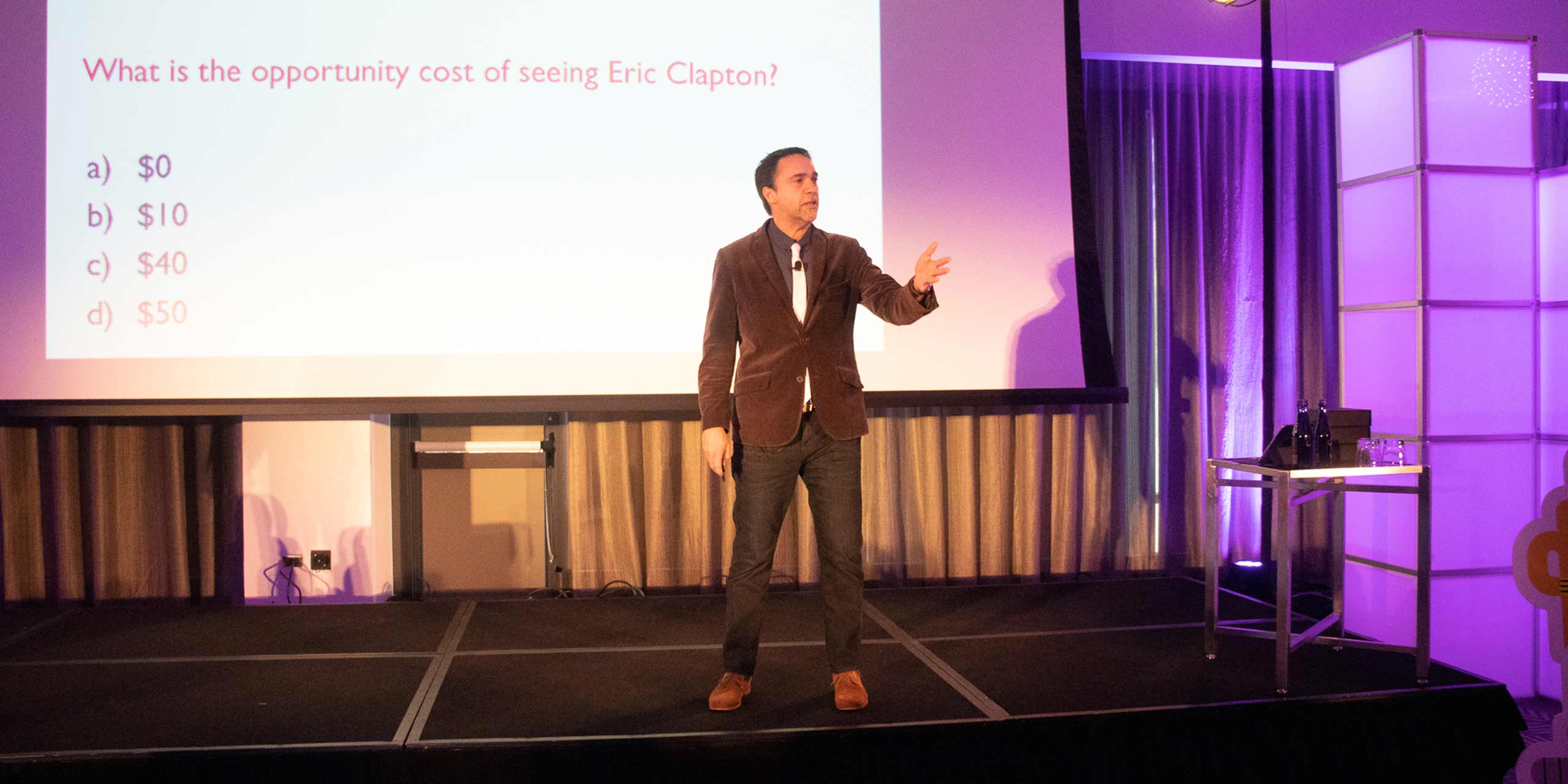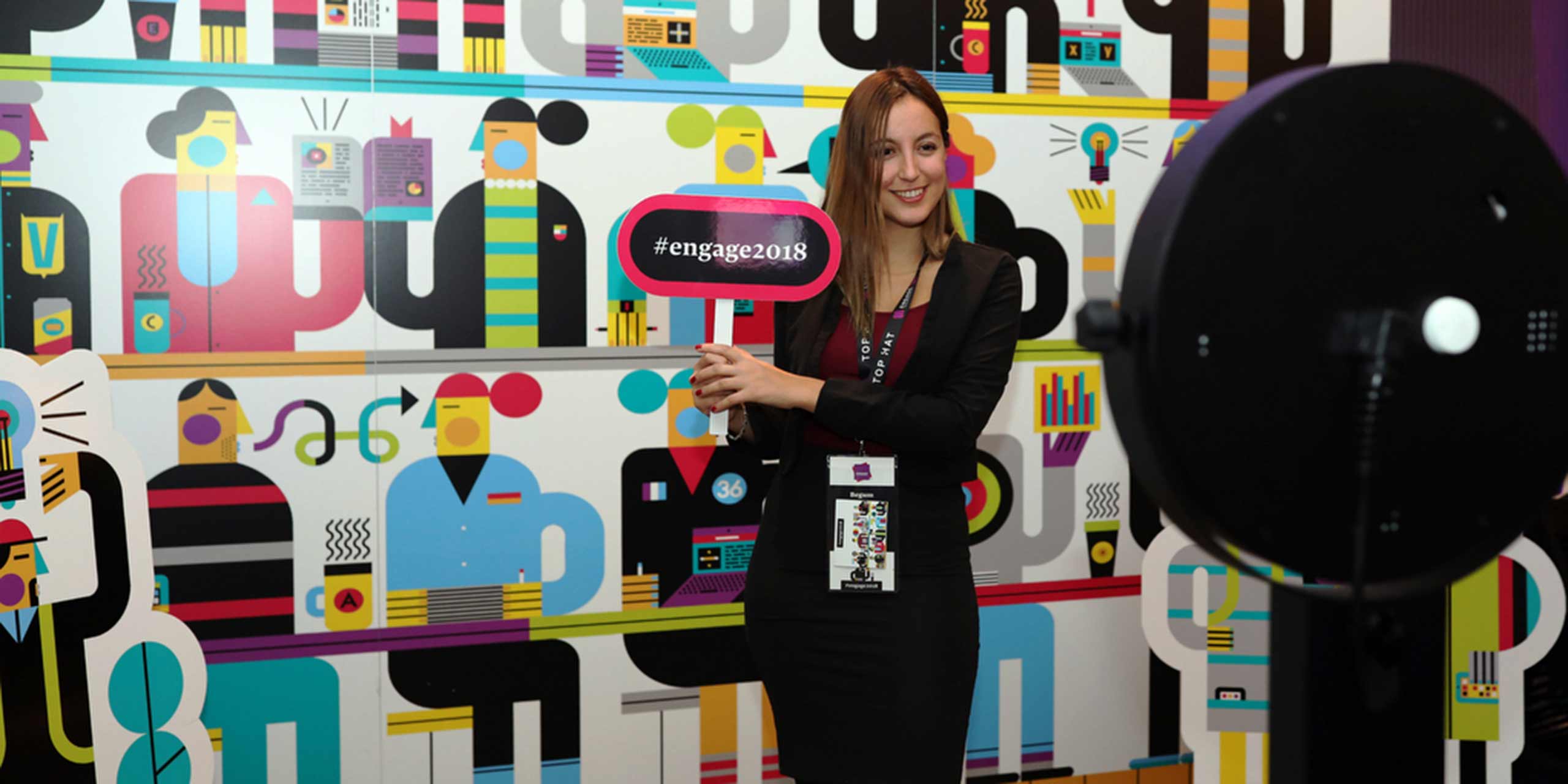Teaching in a modern classroom is much like playing jazz. It’s about taking what people already know, improvising on it, making connections and coloring outside the lines.
All of our speakers at Engage 2018, our yearly Chicago conference for innovative educators, took the theme of the agile classroom to heart. Here are just four tips from the two-day extravaganza that you can take back to your classroom and use.
Not your average conference dinner: 4 piece jazz band, an acrobatic dancer, seriously pretty dessert and signature cocktails! Day 1 of #engage2018 by @tophat is a wrap. pic.twitter.com/3gNylh5LTs
— Top Hat (@TopHat) October 27, 2018
1. What students already know is important
Avoid being disconnected background noise. Build on the phrases and the ideas that your audience is already familiar with, and take them to new places.
Jose J. Vazquez (below), Clinical Professor of Economics at the University of Illinois Urbana-Champaign, teaches several parts of one of the largest Economics courses in the United States. He explained in his Day 1 customer keynote that it’s all too easy to broadcast knowledge from your notes to your students’ notes without information passing into actual learning.

Instead, build knowledge on top of what your students already know. Vazquez explained the “gap theory.” “We become curious when our attention focuses on the information we need to fill subjective gaps in our knowledge.” Find the sweet spot to ask the right in-class questions that are not too obvious, but are also not too obscure, and students will be happy to fill in the parts they’ve missed.
Keynote speaker Jose Vazquez talking about how motivation works and connecting it to how technology has enabled professors to move into the parts of teaching that are hard.
“I believe a big part of teaching is an art” and “having trust is a big part of it”. #engage2018 pic.twitter.com/tHhxWyEIwn
— Top Hat (@TopHat) October 26, 2018
José Vazquez ends his customer keynote by bravely sharing his @RateMyProfessor reviews with #engage2018 attendees… pic.twitter.com/xMqnDDmnMN
— Top Hat (@TopHat) October 26, 2018
Watch José Vazquez’s whole keynote on demand here.
2. Class anxiety can be toxic, but can be overcome
As Vazquez also explained, learning by falling is how children in safe and healthy environments gain knowledge. But a classroom can often be a stressful, high-pressure environment, and that is not a fertile place for students to gain knowledge.
Two instructors who host courses that are by nature perceived as stressful and difficult—public speaking and math for liberal arts students—offered some important guidance in the Day 2 talk, ‘Dealing Constructively with Student Emotions.’
Anxiety is common in the classroom among students, says @LGreenSCTCC. While it can motivate learners to achieve a reward or avoid consequence, it can also be debilitating and overwhelming #engage2018
— Top Hat (@TopHat) October 27, 2018
Luke Green, Professor of Communication Studies at St. Cloud Community College found that in his public speaking course, student anxiety came from a combination of performance (being judged by the instructor) and social anxiety (being judged by one’s peers). He improved grades in his class with a student-focused redesign that validated his students’ perfectly normal feelings of worry, and made those feelings power learning instead. Using Top Hat to power this overhaul, he increased his overall class grades by 5.3 percentage points.
Burcu Karabina, winner of the 2017 Top Hat Innovative Educator award, explained that teaching math as part of a required course to liberal arts students, who are “not supposed” to be good at math, brings its own subset of anxiety—mathematical anxiety, which is self-reinforcing. In fact, 11 percent of university students show high enough levels of mathematics anxiety to be in need of counseling.
"Number anxiety" is a real subset of anxiety, says lecturer Burcu Karabina. 11% of university students show high enough levels of mathematics anxiety to be in need of counseling. But is performance linked to anxiety, or the other way around? #engage2018 pic.twitter.com/LUabspdly5
— Top Hat (@TopHat) October 27, 2018
Using Top Hat, Karabina redesigned her course to remove time pressure, auto-graded results and allowed students to take their own responsibility for learning rather than an external authority. All this and more improved outcomes and feedback, from a course few people initially wanted to take.
Changing your course based on your students’ reactions can have a marked improvement on grades and outcomes. In neither case are the materials less challenging, but making them ensures that people who are nervous about imperfection know that they can still succeed.
3. It’s good for students to see you struggle
A growth mindset prioritizes embracing challenges, listening to criticism and finding inspiration in the success of others—instead of a fixed mindset, which rebuffs criticism, is envious of others’ success and gives up easily at obstacles.
Kyle Anderson, who teaches biochemistry, microbiology and immunology at the University of Saskatchewan, explained that there’s a technology gap for many to overcome when using new tools. Laura Freberg, a Psychology Professor at California Polytechnic State University, added that a fixed mindset leads to discouragement in the face of adversity.
Instead, faculty adopting a growth mindset will overcome difficulties to obtain the results they need—which is, after all, what every instructor wants for their students.
Need a refresher on the #growthmindset? Here's a diagram courtesy of @usask 's Kyle Anderson. #engage2018 pic.twitter.com/SfLWReUmQQ
— Top Hat (@TopHat) October 26, 2018
Top Hat CEO Mike Silagadze opened the conference with this theme in his own keynote—explaining the agile classroom as being in a similar vein to modern software development. It’s a place where you and your students are not afraid to try new things, and fail at them.
The theme of #engage2018 is the Agile Classroom, CEO @MikeSilagadze says in his keynote. It means that nothing is perfect the first time—learn -> try -> fail is how you grow. It's the right way to build software—and it's the right way to build an effective class. pic.twitter.com/BqRwSQJFvf
— Top Hat (@TopHat) October 26, 2018
4. The future is a community, not the ivory tower
You are not a one-man- or woman-band. You are part of a cohort of academics, all with different talents, opinions and strengths, with different life experiences and perspectives. And yet so much of academic life is spent competing with, or locked away from, other people. Top Hat’s Chief Product Officer, Eran Ben-Ari, aimed to start changing this attitude with his keynote, ‘The Power of Community,’ wherein he recounted his experience as a lecturing academic.
Educators can improve student outcomes by working together as a community to address their challenges. Technology is the key to that group effort, says Eran Ben-Ari #engage2018 pic.twitter.com/bji8fHyX4w
— Top Hat (@TopHat) October 27, 2018
It’s particularly important in an age where the upcoming generation of college students have no familiarity with the traditional classroom. It’s here where the power of instructors linking together can be best applied.
This generation lives in an era where multitasking is the norm, their attention to do anything is limited and it can be split into different tasks. This generation is used to learning in a very different way than we used to learn. For us as instructors to be successful teaching this generation, we must change the way we teach.
Because when students and their profs are in harmony, everybody is happy.
Congrats to @tophat on a huge #Engage2018 conference. I didn’t expect to see this many attendees. Shows that more people are opening up to the power of #EdTech for classroom learning. #edtechchat pic.twitter.com/mjWAgZ3uXG
— Tim (@cigelske) October 26, 2018

Watch on demand
The Evolution of Instruction: A New Paradigm for Teaching
José Vazquez, professor of economics at the University of Illinois, discusses what he envisions as the future of teaching in higher ed, and the various ways students stand to benefit from self-paced learning and a re-imagination of the role of the college instructor.
Sign-up below to watch the recording for free.


